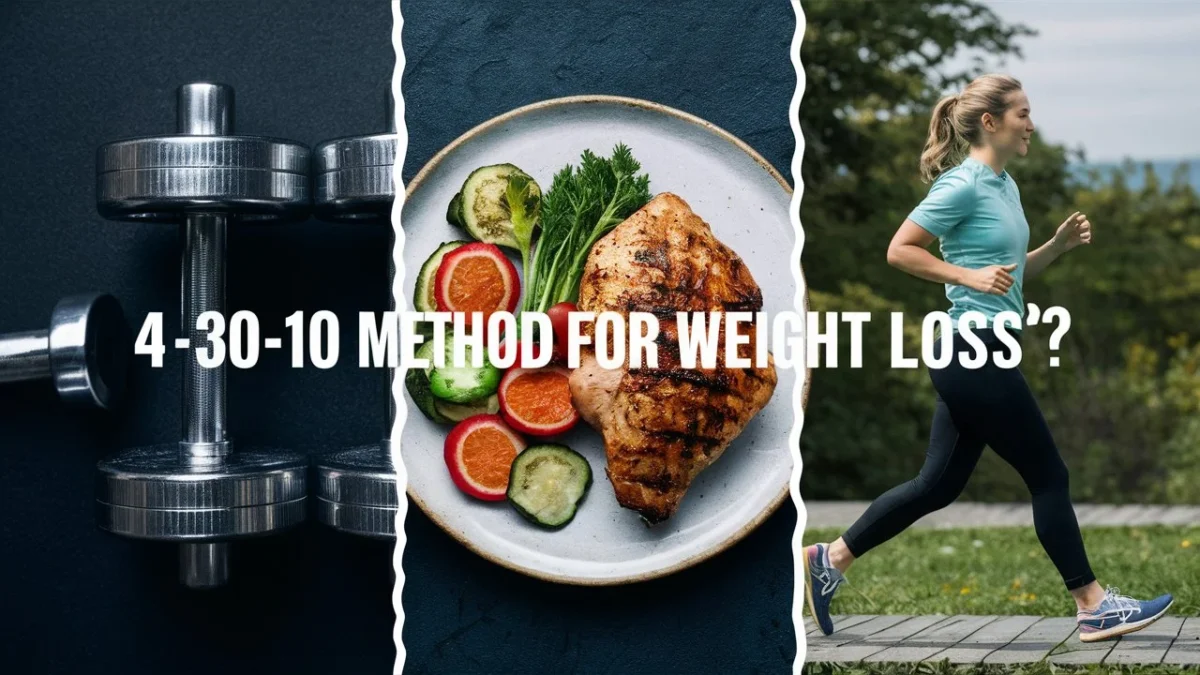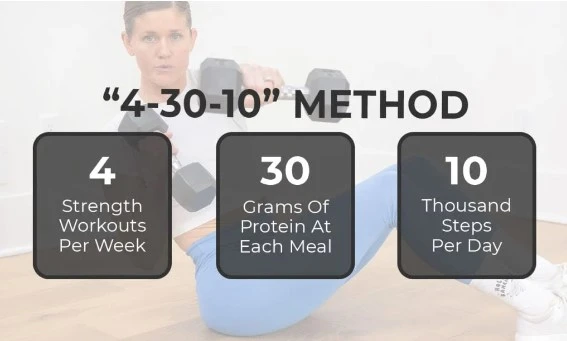Introduction: Exploring the 4-30-10 Method for Weight Loss
The quest for a healthy weight loss journey can feel like an uphill battle. We’ve all been there, bombarded with countless “miracle diets” and conflicting advice. But what if there was a method that combined structure, exercise, and a focus on whole foods? Enter the 4-30-10 method for weight loss, gaining traction for its simplicity and potential effectiveness.
This approach prioritizes strength training, strategic protein intake, and increased daily activity. Whether you’re a seasoned gym-goer or just starting your fitness journey, the 4-30-10 method might be the key you’ve been searching for.
Intrigued by the promise of building muscle while shedding pounds? We’ll be dissecting this method in detail, exploring its components, potential benefits, and how it can help you achieve your weight loss goals. But before we dive in, let’s first understand what the 4-30-10 method entails.
What is the 4-30-10 Method:
The 4-30-10 method isn’t magic, but it offers a clear structure for weight loss by focusing on three key pillars: strength training, protein intake, and daily activity. Let’s break down each aspect:
The Strength in “4”: Aiming for Four Workouts
The number “4” represents the recommended number of strength training sessions per week. Strength training, often overlooked in weight loss plans, plays a crucial role. It builds muscle mass, which not only improves your physique but also boosts your metabolism.
Why Strength Training Matters: Muscle burns more calories at rest than fat, meaning your body becomes a more efficient calorie-burning machine even outside the gym. Additionally, strength training increases bone density, improves strength, and enhances overall fitness, contributing to a healthier you. https://www.acefitness.org/
The Power of “30”: Prioritizing Protein
The “30” refers to targeting 30 grams of protein at each meal (breakfast, lunch, and dinner). Protein is a satiating macronutrient, keeping you feeling fuller for longer and reducing cravings. This can lead to a natural decrease in calorie intake, aiding in weight loss.
Protein’s Role in Weight Loss: When you consume protein, your body expends more energy digesting and absorbing it compared to carbohydrates or fats. This process, called the thermic effect of food (TEF), further contributes to calorie burning. Additionally, protein helps with muscle repair and growth, essential for the muscle-building benefits mentioned earlier. https://www.health.harvard.edu/staying-healthy/the-power-of-protein
It’s Important to Note: The recommended 30 grams of protein per meal can be adjusted based on your individual needs. Factors like body weight, activity level, and fitness goals can influence your protein requirements. Consulting a registered dietitian can help you determine the optimal protein intake for your specific situation.
Reaching for “10”: Increasing Daily Activity
Finally, the “10” signifies aiming for 10,000 steps per day. This daily activity goal helps you burn more calories and contributes to overall health benefits.
Benefits of Increased Activity: Walking 10,000 steps not only aids in weight loss but also improves cardiovascular health, strengthens bones and muscles, and boosts mood and energy levels. It’s a win-win for your physical and mental well-being.
Alternatives for Step Counting: While 10,000 steps is a popular benchmark, it doesn’t have to be a rigid rule. If walking isn’t your forte, consider alternative activities like cycling, swimming, or dancing. Aim for at least 30 minutes of moderate-intensity exercise most days of the week. https://www.mayoclinic.org/healthy-lifestyle/fitness/basics/aerobic-exercise/hlv-20049447
Meals with Protein Power:
Here are a few quick meal ideas incorporating 30 grams of protein each:
- Breakfast: Greek yogurt with berries and a scoop of protein powder
- Lunch: Grilled chicken breast on a whole-wheat bun with lettuce, tomato, and avocado
- Dinner: Salmon with roasted vegetables and a side of quinoa
Other Posts about Meals:
Strength Training Routine:
Warm-up (5 minutes): Light cardio followed by dynamic stretches.
Workout (30-45 minutes):
- Squats (3 sets of 10-12 repetitions)
- Push-ups (modified versions for beginners) or chest press (3 sets of 10-12 reps)
- Rows (using dumbbells or resistance bands) (3 sets of 10-12 reps)
- Overhead press (3 sets of 10-12 reps)
- Lunges (alternating legs) (3 sets of 10-12 reps per leg)
Cool-down (5 minutes): Static stretches to target major muscle groups.
How to get 10,000 steps a day?
Here are some strategies to help you reach your daily goal of 10,000 steps:
Turn Everyday Activities into Steps:
- Park further away: Instead of circling for the closest spot, park further away from your destination and walk the extra distance. This adds steps throughout your day.
- Take the stairs: Whenever possible, ditch the elevator and opt for the stairs. It’s a simple way to sneak in extra steps and get your heart rate up.
- Walk during calls: If you have a phone call that allows for movement, pace around while talking.
- Do household chores with vigour: Turn cleaning into a mini workout! Put on some music and move with purpose while vacuuming, dusting, or organizing.
Integrate Movement Throughout Your Day:
- Set walking breaks: Schedule short walking breaks throughout your workday. Get up, walk around the office, grab a glass of water, or do some stretches at your desk. Aim for at least 5-10 minutes of movement every hour.
- Walk during your lunch break: Instead of sitting through lunch, take a walk around the block or explore a new area.
- Take the scenic route: When walking errands or running quick tasks, choose routes that take you a bit further and offer a more scenic view.
Make Walking Fun and Social:
- Find a walking buddy: Having a friend or family member to walk with can make it more enjoyable and hold you accountable.
- Join a walking group: Look for local walking groups or fitness apps that offer walking challenges or group walks.
- Explore your surroundings: Take walks in new neighbourhoods, parks, or nature trails.
- Listen to podcasts or audiobooks: Distract yourself from the effort and enjoy some entertainment while you walk.
- Invest in a fitness tracker: Track your daily steps and see your progress over time. Fitness trackers can also offer challenges and motivate you to reach your goals.
Small Steps Lead to Big Results:
- Don’t be discouraged if you don’t reach 10,000 steps every day: Start by gradually increasing your daily steps. Even small increases can make a big difference over time.
- Focus on consistency: Aim for at least 30 minutes of moderate-intensity exercise most days of the week.
- Celebrate your achievements: Acknowledge your progress and reward yourself for reaching milestones.
Benefits of the 4-30-10 Method:
The 4-30-10 method isn’t just about shedding pounds; it offers a holistic approach to weight loss with benefits extending far beyond the number on the scale. Here’s how this method can supercharge your weight loss journey and contribute to your overall well-being:
Building a Calorie-Burning Machine:
Strength training, a cornerstone of the 4-30-10 method, plays a key role in boosting your metabolism. By building muscle mass, you create a more efficient calorie burner. Muscle burns more calories at rest compared to fat, meaning even when you’re not actively exercising, your body is working harder to maintain that muscle, leading to increased calorie expenditure throughout the day.
Feeling Full and Staying Satisfied:
Protein, a key component of the 30-gram target per meal, is your friend when it comes to feeling full and managing cravings. Protein takes longer to digest than carbohydrates, promoting satiety and keeping you feeling fuller for longer. This can naturally lead to reduced calorie intake throughout the day, aiding in weight loss efforts.
Turning Up the Fat-Burning Furnace:
The combination of strength training and increased activity (10,000 daily steps) creates a powerful calorie-burning duo. Strength training helps build muscle, which boosts your metabolism as mentioned earlier. Increased daily activity further adds to the calorie deficit equation. By burning more calories than you consume, you create an environment conducive to weight loss and fat burning.
More Than Just the Scale: A Healthier You:
The benefits of the 4-30-10 method go beyond just weight loss. Strength training builds stronger bones and muscles, improving overall physical strength and reducing the risk of injuries. Increased activity strengthens your cardiovascular system, boosting heart health. Additionally, the combination of protein intake and exercise can improve energy levels and mood, leading to a more vibrant and active lifestyle.
Who Can Benefit From The 4-30-10 Method Workout Plan?
As a certified trainer, here’s who can benefit from the 4-30-10 Method Workout Plan:
People Looking to Lose Weight and Build Muscle:
- This plan is a great option for those who want to shed pounds while building or maintaining muscle mass. Strength training is a key component, which helps boost metabolism and burn more calories at rest.
Individuals New to Fitness:
- The 4-30-10 method offers a structured approach with clear goals. Beginners can start with bodyweight exercises or lighter weights and gradually increase intensity as they get stronger.
Those Seeking Improved Overall Health:
- This plan goes beyond just weight loss. The combination of strength training, protein focus, and increased activity can lead to improved bone density, stronger muscles, a healthier cardiovascular system, and potentially better mood and energy levels.
People with Busy Schedules:
- The 4-30-10 method promotes consistency with four 30-45 minute strength training sessions and daily activity goals that can be broken down into smaller chunks (e.g., taking the stairs, parking further away).
Here are some additional points to consider:
- Pre-existing Conditions: While generally safe, it’s always recommended to consult a doctor before starting any new program, especially if you have any pre-existing health conditions.
- Modifications: The beauty of this plan is its flexibility. I can help you tailor the exercises, weight amounts, and activity goals to fit your fitness level and any limitations you may have.
- Individual Needs: We can discuss your specific goals (weight loss, muscle building, overall fitness) and adjust the protein intake based on your body weight and activity level.
Who Might Not See Optimal Results
While the 4-30-10 method is a great starting point, it might not be the most optimal approach for everyone. Here are some exceptions:
- Elite Athletes: This plan might not offer enough challenges for highly trained athletes who require more specific and intense training programs.
- People with Significant Weight Loss Goals: If you have a significant amount of weight to lose, a combination of this plan with a calorie deficit managed by a registered dietitian might be more effective.
Overall, the 4-30-10 method is a versatile plan that can benefit a wide range of people. As a certified trainer, I can help you customize it to fit your individual needs and goals.
Considerations and Modifications:
The 4-30-10 method offers a solid foundation for weight loss, but it’s important to remember that a one-size-fits-all approach rarely exists. Here’s how to personalize the plan to fit your unique needs and preferences:
Finding Your Perfect Fit: Individual Needs
The beauty of the 4-30-10 method lies in its flexibility. Here’s how to adjust it based on your situation:
- Fitness Level: Beginners: Start with lighter weights, fewer repetitions, and gradually increase intensity as you get stronger. Focus on proper form to avoid injury. Advanced Fitness Enthusiasts: Challenge yourself with heavier weights, more sets and repetitions, and explore advanced exercise variations.
- Goals: Pure Weight Loss: Prioritize creating a calorie deficit by focusing on portion control alongside the 4-30-10 method. Muscle Building: Increase your protein intake beyond the 30-gram target per meal, and consider consulting a trainer for a personalized strength training routine.
- Dietary Restrictions: Vegetarians and vegans can incorporate protein-rich plant-based options like legumes, tofu, tempeh, and lentils. Individuals with allergies or specific dietary needs should consult a registered dietitian to ensure they’re meeting their nutritional requirements within the framework of the 4-30-10 method.
Safety First: Consulting a Healthcare Professional
Before starting any new exercise program, especially if you have any pre-existing health conditions, consult a healthcare professional. They can assess your fitness level, provide guidance on modifications, and ensure the 4-30-10 method aligns with your overall health goals.
Making it Last: The Power of Sustainability
The key to success with the 4-30-10 method, or any weight loss plan for that matter, lies in consistency. Here are some tips to make healthy habits stick:
- Find Activities You Enjoy: Don’t force yourself into activities you dislike. Explore different exercise options like dancing, swimming, or team sports to find something you genuinely enjoy.
- Small Steps, Big Results: Start with small, achievable goals and gradually increase the intensity and duration of your workouts as you get stronger. Consistency is key, so focus on making the plan a regular part of your routine.
- Plan and Prep: Meal prep can be a lifesaver! Plan your meals and snacks in advance to avoid unhealthy choices when hunger strikes.
- Find a Support System: Enlist a friend, or family member, or join an online fitness community for encouragement and accountability. Sharing your journey with others can boost motivation and keep you on track.
Modifications for Everyone: Making it Work for You
The 4-30-10 method can be adapted to fit various fitness levels and limitations:
- Beginner Modifications: Start with bodyweight exercises like squats, lunges, push-ups (modified versions on knees if needed), and planks. Use lighter weights and gradually increase as you get stronger. Aim for 2-3 sets of 8-12 repetitions per exercise.
- Alternative Exercises: If you have limitations or injuries that prevent certain exercises, explore alternatives. For example, if running is difficult, try swimming or cycling.
- Dietary Adjustments: Vegetarians and vegans can incorporate protein-rich plant-based options as mentioned earlier. People with allergies or specific dietary needs can work with a registered dietitian to ensure they meet their protein requirements within the framework of the 4-30-10 method.
Remember, the key is to find a routine you can stick with in the long term. Don’t be afraid to experiment and modify the 4-30-10 method to create a plan that works best for you and your lifestyle.
FAQs About the 4-30-10 Method for Weight Loss
As a certified trainer, I frequently hear questions about the 4-30-10 method for Weight Loss. Here are some of the most common ones answered:
Q. What is the 4-30-10 Method?
The 4-30-10 method is a weight loss plan that focuses on three key aspects:
- 4 Strength Training Workouts: Aiming for four sessions per week helps build muscle, which boosts metabolism and burns more calories at rest.
- 30 Grams of Protein per Meal: Targeting this amount at breakfast, lunch, and dinner promotes satiety and potentially reduces cravings.
- 10,000 Steps Daily: This activity goal helps burn more calories and contribute to overall health.
Q. Who can benefit from the 4-30-10 method?
This plan is a great option for:
- People looking to lose weight and build muscle.
- Individuals new to fitness.
- Those seeking improved overall health and well-being.
- Busy individuals seeking a structured approach with achievable goals.
Q. I’m a beginner. Can I still do the 4-30-10 method?
Absolutely! The beauty of this plan is its flexibility. I can help you modify exercises, starting with body weight or lighter weights, and gradually increase intensity as you get stronger.
Q. What if I can’t walk 10,000 steps every day?
No worries! While 10,000 steps is a great target, you can still benefit from increased activity. Aim for at least 30 minutes of moderate-intensity exercise most days. Consider alternatives like cycling, swimming, or dancing.
Q. Do I have to eat exactly 30 grams of protein at every meal?
This can be a guideline. The optimal protein intake depends on your factors like body weight and activity level. We can discuss this and adjust as needed.
Q. What if I have dietary restrictions?
The 4-30-10 method can be adapted! Vegetarians and vegans can incorporate plant-based protein sources like legumes, tofu, tempeh, and lentils. If you have allergies or specific dietary needs, we can work together to ensure you meet your protein requirements within this framework.
Q. Is it safe to start the 4-30-10 method if I have health conditions?
Always consult a doctor before starting any new program, especially if you have pre-existing health conditions. They can help ensure this plan aligns with your overall health goals.
Q. I’m worried I won’t be able to stick with the 4-30-10 method long-term.
Consistency is key! Here are some tips:
- Find activities you enjoy. Exercise shouldn’t feel like a chore. Explore different options!
- Start small and gradually increase intensity. Focus on making it a regular part of your routine.
- Plan and prep your meals. This helps avoid unhealthy choices when hunger strikes.
- Find a support system. Share your journey with a friend, family member, or an online community for accountability and motivation.
Conclusion:
The 4-30-10 method offers a structured approach to weight loss by incorporating strength training, strategic protein intake, and increased daily activity. This combination helps build muscle, boost metabolism, promote satiety, and burn more calories, paving the way for successful weight loss.
Beyond the scale, the 4-30-10 method offers a path to a healthier you. Strength training builds stronger bones and muscles, while increased activity strengthens your cardiovascular system. The protein focus can improve energy levels and mood.
Remember, the beauty of this method lies in its flexibility. Individualize the plan based on your fitness level, goals, and dietary needs. Start slow, prioritize consistency, and find ways to make it a sustainable part of your lifestyle.
Ready to take charge of your health and well-being? Give the 4-30-10 method a try! We’d love to hear about your experiences. Share your thoughts, modifications, or questions in the comments below – let’s embark on this journey together!






